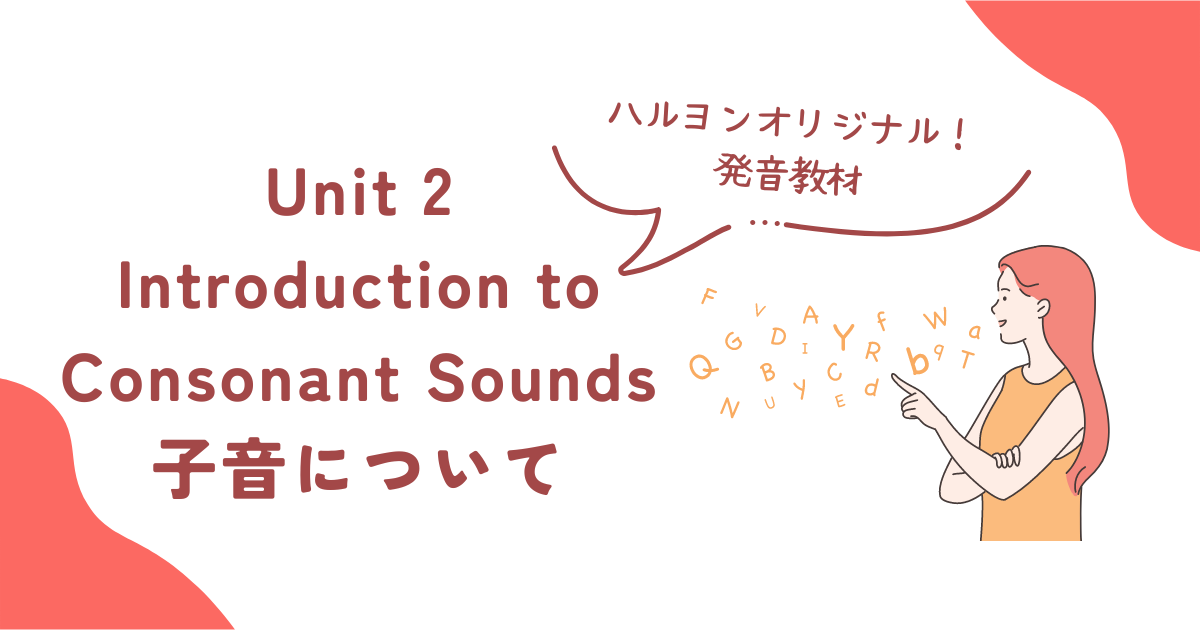The English Consonants | 英語の子音
- Below are the list of the English consonants with a sample word for each sound. The RIGHT SIDE of the table indicates HOW the words are pronounced (MANNER OF ARTICULATION), while the UPPER PART of the table indicates WHERE in the mouth the sounds are pronounced (PLACE OF ARTICULATION).
-
以下は、英語の子音一覧と、それぞれの音のサンプル単語です。表の右側は、単語がどのように発音されるか(MANNER OF ARTICULATION)を示し、表の上側は、口の中のどこで発音されるか(PLACE OF ARTICULATION)を示しています。
| Manner of Articulation | Place of Articulation | |||||||
|---|---|---|---|---|---|---|---|---|
| Bilabial (both lips) | Labiodental (lip and teeth) | Interdental (in between upper and lower teeth) | Alveolar (back part of the upper teeth) | Post-alveolar (front part of the roof of the mouth) | Palatal (back part of the roof of the mouth) | Velar (back part of the roof of the mouth) | Glottal (throat) | |
| Stop (The air is stopped) | /p/ pen | /t/ ten | /k/ kick | |||||
| /b/ Ben | /d/ den | /g/ gig | ||||||
| Fricative (Smooth air flows through a space. The air is causing friction). | /f/ fan | /θ/ thin | /s/ Sue | /ʃ/ mission | /h/ hen | |||
| /v/ van | /ð/ thy | /z/ zoo | /ʒ/ vision | |||||
| Affricate (stop and then a smooth airflow with friction) | /tʃ/ church | |||||||
| /dʒ/ Jane | ||||||||
| Nasal (The air is released through the nose.) | /m/ men | /n/ nine | /ŋ/ sing | |||||
| Liquid (The sound is produced smoothly like a liquid through a small space) | /l/ late /r/ rate | |||||||
| Glide (A very quick sound that is almost like a vowel) | /w/ wood | /j/ year | ||||||
- The English consonant sounds are pronounced by blocking the air and sound using the articulators. There are two types of consonant sounds according to air flow.
-
英語の子音は、空気を遮断し、音節を用いて発音します。子音の発音は、息の流れによって2種類に分けられます。
Continuants | 継続音
/f/, /v/, /θ/, /ð/, /s/, /z/, /ʃ/, /ʒ/, /h/, /tʃ/, /dʒ/, /m/, /n/, /ŋ/, /l/, and /r/
- Continuant sounds , both voiced and voiceless can be pronounced CONTINUOUSLY for as long as the speaker produces air and sound.
-
継続音は、有声音、無声音ともに、話し手が空気と音を出す限り、継続的に発音することができる。
Let Us Practice | 練習しよう
- /ffff/, /fffffain/ fine
- /ffff/, /pʌffff/ puff
- /ssss/, /ssssʌn/ sun
- /ssss/, /messss/ mess
- /llll/, /llllait/ light
- /llll/, /meil/ mail
Stops | 停止音
/p/, /b/, /t/, /d/, /k/, /g/
- Stop sounds are pronounced when there a COMPLETE STOP of airflow and sound. However, not all stop sounds are pronounce the same. Native speakers pronounce sounds are pronounced with a puff of air (ASPIRATE).
-
停止音は、息と音が完全に止まったときに発音されます。しかし、すべての停止音が同じように発音されるわけではありません。ネイティブ・スピーカーの発音は、空気をふくませて発音します(気音)。
Aspiration | 有気音
- Aspiration (represented by a small /ʰ/) happens when a voiceless stop is placed in the beginning of a stressed syllable. Look at the words below. You will notice that when you pronounce voiceless stops in the middle or in the final part of a word, there is no puff of air.
-
有気音(小さな /ʰ/ で表される)は、無声停止が強調音節の先頭に置かれたときに起こります。下の単語を見てください。単語の真ん中や最後に無声音停止を発音するとき、空気のふくらみがないことにお気づきでしょう。
Let Us Practice | 練習しよう
- appear [ə.pʰíɚ]
-
姿を見せる、出現する、現われる
- ripper [ɹí:pɚ]
-
引き裂く人
- apply [ə.plái]
-
用いる、(…に)適用する
- brick [brík]
-
れんが、れんが状のもの、(おもちゃの)積み木
- wrecker [ré.kɚ]
-
解体業者、レッカー車
- accomplish [ə.kʰɑ́m.pliʃ]
-
成し遂げる、完成する、果たす
- ticket [tʰi.kit]
-
切符、入場券、乗車券
- bitten [bi.tn]
-
bite の過去分詞
- Victor [vík.tɚ]
-
(名前)








